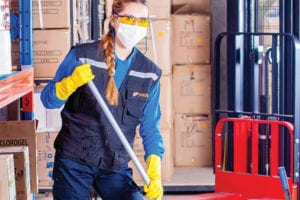Safely Returning to Work – What does it mean for the Staffing Industry?
May 11, 2020
 Returning to a safe work environment is the number one topic of discussion right now in the United States. It is on the mind of every business owner. This holds a separate set of challenges for the staffing industry. Not only do staffing agencies need to be concerned about keeping its internal associates safe, but also temporary employees who are working at various client companies.
Returning to a safe work environment is the number one topic of discussion right now in the United States. It is on the mind of every business owner. This holds a separate set of challenges for the staffing industry. Not only do staffing agencies need to be concerned about keeping its internal associates safe, but also temporary employees who are working at various client companies.
We have compiled a list of frequently asked questions by staffing agency owners. The following suggestions will reduce the risk of the spread of COVID-19 and help keep your employees safe when returning to work.
1. Does each of my clients have a COVID-19 Preparedness Plan in place in order to ensure a safe work environment for my temporary employees?
- If available, request a copy of your client’s COVID-19 Preparedness Plan for the client file. Guidelines available through the Department of Labor site https://www.dol.gov/ OR, your State Department of Labor website.
- Update your client worksite assessment form to include questions around COVID-19 and new safety requirements.


- Consider doing an updated worksite assessment before new placements with your existing clients.
- If your firm primarily staffs: office, professional, or technical positions, it is quite possible that you have not historically conducted client safety assessments. You may want to consider a new standard operating procedure, which includes adding this step to your sales process.
- On May 4th, the U.S. Department of Labor’s Occupational Safety and Health Administration (OSHA) has translated and published its “Ten Steps All Workplaces Can Take to Reduce Risk of Exposure to Coronavirus” poster in 11 additional languages. Make sure you and your clients have the updated sign. https://www.osha.gov/news/newsreleases/national/05042020
- **For those of you with State Specific regulations (such as Minnesota), please check your State-specific site for OSHA guidelines.
2. How do I conduct the worksite assessment if I cannot do it in person?
You may run into challenges that prevent you from doing an in-person worksite assessment. These obstacles might include things such as client location, remote recruiting, or client restrictions 

Instead of an on-site assessment, the following are some other possible considerations:
- Request that pictures or videos of specific work areas are sent digitally.
- Do a live video call with your contact at the client company to assess the workspace.
- When recruiting, always obtain clear, detailed, and up to date job descriptions of all positions.
- Now, more critical than ever, it is vital to have direct contact with hiring managers to ensure that the day-to-day training and safety of our employees is in place.
3. How do I increase the level of communication with my temporary employees and ensure trust in providing a safe work environment?
Employees who do not have confidence in being placed in a safe work environment will result in increased job offer declines, no shows, low productivity, and high turnover. 

Here are some suggestions on what you can do to help ease fear around safety:
- It starts with the recruiting and interview process. Explain your procedures and everything your firm has in place to ensure the general safety of all employees. This includes letting them know that you are working with companies that have a COVID-19 preparedness plan. Make it known that there will be updated and improved assignment details and instructions.
- General Onboarding: Be sure to add COVID-19 preparedness items to your general safety checklist and orientation.
- When emailing or uploading new assignment details to the employee portal, make sure to include pictures or videos of the worksite, so the employee feels prepared. Ensure they understand first-day reporting procedures and safety protocol.
- Make sure employees understand your procedure for reporting an unsafe work environment or incidents.
- Employee engagement after placement is even more critical now. Increase your standard check-ins. A good practice is a check-in after the first day, and a follow up at the end of the first week. This will allow you to thank your employee, make sure the job description is accurate, and that safety protocol is being followed.
This has been unprecedented times for businesses across the U.S.; every industry has been affected one way or another. The most effective way to rebuild the economy is to get back to work. However, this must be done safely and efficiently. Have a plan and process in place before inviting employees back to work. Continuously stay up to date on federal and state guidelines for policy adjustments. Remember, getting employees back to work is going to be a slow process that does not happen overnight. Safety is first and foremost; the rest will come with time as we enter the “new normal.”
Scale Funding
Scale Funding understands what you, as a business owner is facing during this difficult time. We are here for you. Since 1994, Scale Funding has specialized in payroll funding services staffing agencies across the United States. We offer reliable cash-flow solutions, enabling staffing companies to meet payroll, fill more orders, and grow.


